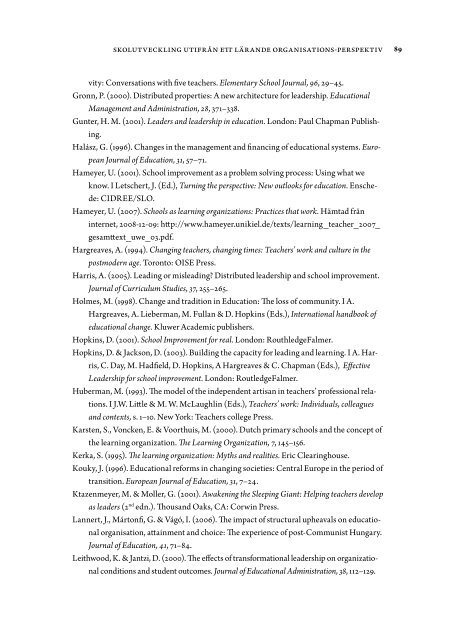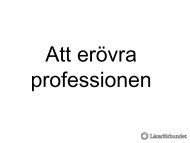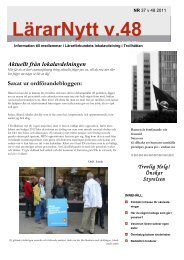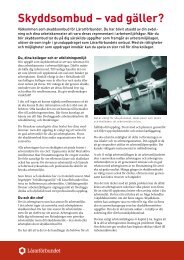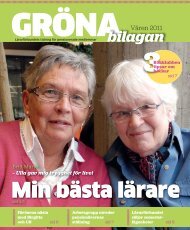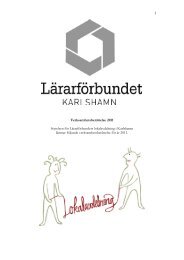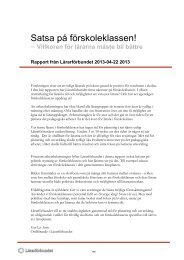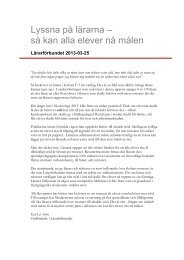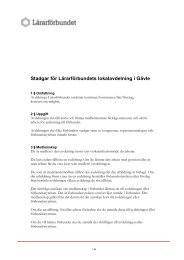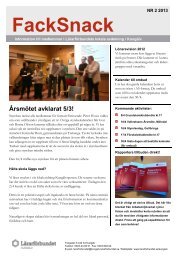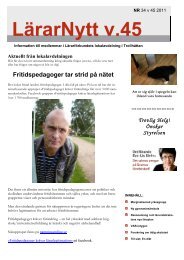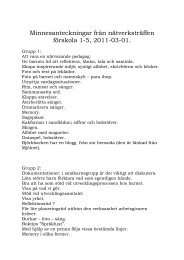Med ansiktet vänt mot Europa - Lärarförbundet
Med ansiktet vänt mot Europa - Lärarförbundet
Med ansiktet vänt mot Europa - Lärarförbundet
You also want an ePaper? Increase the reach of your titles
YUMPU automatically turns print PDFs into web optimized ePapers that Google loves.
skolutveckling utifrån ett lärande organisations-perspektiv<br />
vity: Conversations with five teachers. Elementary School Journal, 96, 29–45.<br />
Gronn, P. (2000). Distributed properties: A new architecture for leadership. Educational<br />
Management and Administration, 28, 371–338.<br />
Gunter, H. M. (2001). Leaders and leadership in education. London: Paul Chapman Publishing.<br />
Halász, G. (1996). Changes in the management and financing of educational systems. European<br />
Journal of Education, 31, 57–71.<br />
Hameyer, U. (2001). School improvement as a problem solving process: Using what we<br />
know. I Letschert, J. (Ed.), Turning the perspective: New outlooks for education. Enschede:<br />
CIDREE/SLO.<br />
Hameyer, U. (2007). Schools as learning organizations: Practices that work. Hämtad från<br />
internet, 2008-12-09: http://www.hameyer.unikiel.de/texts/learning_teacher_2007_<br />
gesamttext_uwe_03.pdf.<br />
Hargreaves, A. (1994). Changing teachers, changing times: Teachers’ work and culture in the<br />
postmodern age. Toronto: OISE Press.<br />
Harris, A. (2005). Leading or misleading? Distributed leadership and school improvement.<br />
Journal of Curriculum Studies, 37, 255–265.<br />
Holmes, M. (1998). Change and tradition in Education: The loss of community. I A.<br />
Hargreaves, A. Lieberman, M. Fullan & D. Hopkins (Eds.), International handbook of<br />
educational change. Kluwer Academic publishers.<br />
Hopkins, D. (2001). School Improvement for real. London: RouthledgeFalmer.<br />
Hopkins, D. & Jackson, D. (2003). Building the capacity for leading and learning. I A. Harris,<br />
C. Day, M. Hadfield, D. Hopkins, A Hargreaves & C. Chapman (Eds.), Effective<br />
Leadership for school improvement. London: RoutledgeFalmer.<br />
Huberman, M. (1993). The model of the independent artisan in teachers’ professional relations.<br />
I J.W. Little & M. W. McLaughlin (Eds.), Teachers’ work: Individuals, colleagues<br />
and contexts, s. 1–10. New York: Teachers college Press.<br />
Karsten, S., Voncken, E. & Voorthuis, M. (2000). Dutch primary schools and the concept of<br />
the learning organization. The Learning Organization, 7, 145–156.<br />
Kerka, S. (1995). The learning organization: Myths and realities. Eric Clearinghouse.<br />
Kouky, J. (1996). Educational reforms in changing societies: Central Europe in the period of<br />
transition. European Journal of Education, 31, 7–24.<br />
Ktazenmeyer, M. & Moller, G. (2001). Awakening the Sleeping Giant: Helping teachers develop<br />
as leaders (2 nd edn.). Thousand Oaks, CA: Corwin Press.<br />
Lannert, J., Mártonfi, G. & Vágó, I. (2006). The impact of structural upheavals on educational<br />
organisation, attainment and choice: The experience of post-Communist Hungary.<br />
Journal of Education, 41, 71–84.<br />
Leithwood, K. & Jantzi, D. (2000). The effects of transformational leadership on organizational<br />
conditions and student outcomes. Journal of Educational Administration, 38, 112–129.<br />
89


